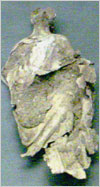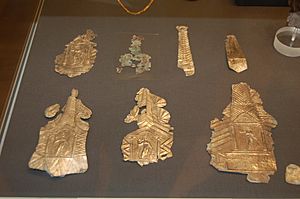Senuna facts for kids
Senuna was a special goddess from ancient times. People in Roman Britain worshipped her. She was a Celtic goddess, meaning she was part of the old Celtic religion.
For a long time, no one knew about Senuna. Then, in 2002, something amazing happened! A metal detectorist named Alan Meek found 26 special gifts, called votive offerings, in a field. This field was in a place called Ashwell End in Hertfordshire.
These discoveries showed us what Senuna might have looked like. Her images mix ideas from a very old goddess with the Roman goddess Minerva. It's a bit like how the goddess Sulis was combined with Minerva at Bath.
Senuna's special place of worship was more than just a small shrine. It had a central area where people threw their offerings. This area was like a special dumping ground for gifts.
Around this area were other buildings. These buildings might have been workshops. They also could have been places for people visiting the shrine to stay. This shows it was a very important place, not just a simple shrine by the road.
The special items found at the shrine were buried together. This happened in the late 200s or 300s CE. People might have buried them to keep them safe for a while.
Contents
What Gifts Were Given to Senuna?
People gave many different kinds of gifts to Senuna. These gifts are called offerings. They included beautiful silver plaques with gold parts. There were also seven gold plaques.
A wonderful set of jewelry was also found. This included a brooch and clasps for cloaks. The plaques were very thin. They had metal tabs so they could stand up. When standing, they would have shimmered and sparkled in any breeze. Some plaques had tiny holes punched into them. Others had designs scratched into them.
The jewelry used older gems and glass beads. One amazing piece was a carved stone. It showed a lion stepping on an ox skull. This carving was already old and worn when it was put into the brooch. All the jewelry had detailed designs. These designs were made with tiny coiled wires. It is possible that this jewelry set was made just to be an offering.
You can see some of these offerings today. They are in Room 49 of the British Museum. They are labeled as the "Near Baldock Hoard."
Besides the jewelry, other things were found. There were old Celtic coins. Most of these coins were hundreds of years old when they were buried. There were also metal items from the Bronze Age. These might have been collected from old burial mounds nearby. People also left food offerings. These included piglets and small amounts of human bone that had been cremated.
Messages to the Goddess: Inscriptions
The collection of items for Senuna includes at least five inscriptions. These are like messages written to the goddess.
One example of an inscription says:
- "To the goddess Senua[.....] Firmanus [.....] willingly fulfilled his vow."
Another message was found on a jewelry offering. It was left by a man from Spain named Servandus. It says:
- "Servandus Hispani willingly fulfilled his vow to the goddess."
These inscriptions show that people made promises, or vows, to Senuna. They then offered gifts to her when their wishes came true.
How Senuna Was Pictured
The silver statue found shows Senuna as a graceful woman. Her hair is coiled up in a bun. Sadly, the goddess's face wore away in the soil over many centuries.
Her arms have been put back together using other pieces found. It looks like she was holding some ears of corn in her right hand. In her left hand, she might have held a special dish or a sacrificial cake.
People believe she was originally standing on a base. This base had an inscription on it. It said that a woman named Flavia Cunoris willingly fulfilled her vow to the goddess Senuna.
At least twelve of the plaques show images of the Roman goddess Minerva. These images show Minerva with her spear, shield, and an owl. However, five of these plaques had inscriptions. These inscriptions said they were dedicated to Senuna, not Minerva. This shows how the two goddesses were seen as similar.
What Does the Name Senuna Mean?
Senuna's name appears in different ways on the plaques. Sometimes it is written as Senuna. Other times it is Sena or Senua.
It is possible that her name comes from a very old Celtic word. This word is "*seno-", which means 'old'. This suggests she might have been seen as an ancient or wise goddess.
Modern Interest in Senuna
The discovery of the offerings to Senuna has inspired people today. Various groups who practice modern Neopaganism have become interested in her. This includes people in the United States and Britain. They are interested in learning about and honoring ancient goddesses like Senuna.



